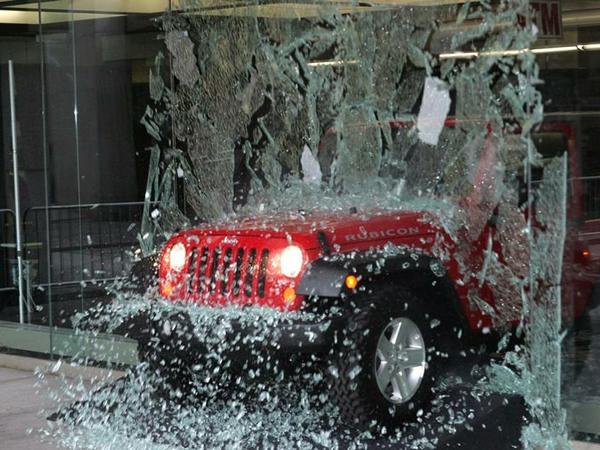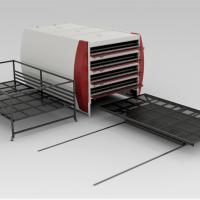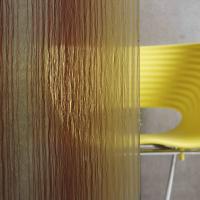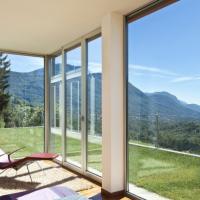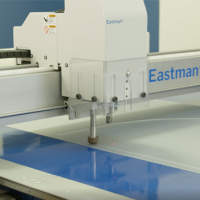First presented at GPD 2017
1. Introduction
Laminated glass as we know it today was originally produced with PVB which was developed and patented exactly 80 years ago. It’s original application was to increase the safety of automotive windscreens by combining the properties of glass with the properties of a thermoplastic polymer modified with a plasticizer.
The first requirement for the PVB interlayer was enhanced safety through glass shard retention and later on impact performance. To achieve this, polymer chemistry and interlayer thickness were modified consecutively to meet the increasing requirements of the automotive windscreen.
For the first 50 years this was the only application for PVB with well-defined requirements and specifications: 0.76mm caliper, a controlled adhesion to meet the impact performance and in some cases tinting of the interlayer for esthetical and shading requirements.
The use of laminated glass in architectural application started to develop about 35 years ago. It was originally driven by the following requirements of the building industry:
- Increased daylighting in building through more glass surfaces
- Development of safety standards in building codes
More recently, new requirements have added challenges to the performance of laminated glass:
- UV filtration performance
- Acoustic performance
- Larger glass panes and minimally supported glass.
- Post breakage performance
- Enhance glazing system performance for: - Blast and ballistic resistance - Very high wind load and debris resistance for hurricane sensitive areas
- Concerns about the safety performance of tempered glass
- Durability and performance in open edge and silicone sealed applications.
- Changes is colour and transparency/ translucency
- Material inclusion and combination with glass coatings
Laminated glass is also increasingly challenged to help meet the energy control requirements imposed on new and retrofitted buildings.
These requirements have led to a dramatic increase of interlayer solutions. At the beginning some of these challenges were met through modification of the original “automotive” PVB: Interlayer thickness ranging from 0.38mm up to 4.56mm or more, sheet size increase and introduction of colors for architectural applications including translucency.
However, as the architectural laminated glass market was maturing, the original PVB recipe proved to have its limitations for architectural applications. This led to the modification of the PVB recipe for applications such as enhanced acoustics, and the development of other polymers such as ionomers and EVA.
The paper “Laminated Glass and interlayers – Breaking the Myths” by Ir.-Arch. Reinout Speelman and Dr. Gerard Savineau presented at GPD 2013 gives an overview of the main interlayers used in modern laminated glass. In this paper I will be covering more in details the applications of laminated glass.
2. Lamination process, quality and cost:
While laminated glass and it’s interlayer have considerably evolved during the last 80 years, so did the lamination process. This was important to increase the product availability, allow innovation through new products and improve the cost position of laminated glass for the construction industry
a) Roller line:
Most of the laminated glass produced worldwide is produced on this type of line. The improvements in this technology together with improvement on the processability of the interlayer have led to automated lines with high yield and high throughput.
This allowed the production of laminated glass up to 321cmx600cm at very competitive costs and price. These lines have been the main driver for the high growth of laminated glass in Europe.
Following this process, the glass needs to be autoclaved to complete the lamination process.
b) Vacuum bag and vacuum ring line:
More complex laminated glass constructions, such as curved glass, some types of multilayered make-ups and less conventional glass shapes and geometries will require this type of lamination process. It is more labor intensive and has a lower productivity, but gives a high level of flexibility and yields which can be important important when high value glass and interlayer are used.
This process generally also includes a vacuum cycle, but some lamination line manufacturers also offer a system without autoclave, a solution generally selected for it’s low investment.
The lamination costs is an important part of the total cost.
Another recent factor on cost and price is the latest generation of structural interlayer that allows to down gage the glass thickness under specific load conditions reducing the total cost of the construction. With glass price increasing exponentially with thickness, this feature is important at high load conditions and for reduced glass support conditions.
3. Which interlayer is used for which application?
a) Standard PVB:
This interlayer is still used in more than 70% of the applications. It’s primary function is to enhance safety or security performance of the glazing and at the same time improve the acoustic and UV protection performance in single and double glazed units. It’s main application is in traditional four side supported glazing in windows and façade systems. It is still used in special glazing application such as overhead, floor and balustrade applications, but is getting increasingly replaced by more performant interlayers for those applications.
b) Structural interlayers:
There are basically 2 families of structural interlayers:
- Ionoplast interlayers
- Stiff PVB (low plasticizer
These interlayers with much higher shear and elastic modulus enhance the coupling between the glass panes increasing the strength of the laminate. Stress and deflection are reduced which will allow the use of lower laminated glass thickness and/or increased glass span.
The extra stiffness of the interlayer does also enhance post breakage performance, especially in tempered laminated constructions which is a limitation with standard PVB.
These enhancements make these interlayers particularly well suited for structural applications such as:
- Minimally supported glass constructions
- Overhead glazing
- Structural balustrade systems.
- Replacement of glazing systems made-up with a monolithic tempered glass system (Eliminate risks related to nickel-sulfide spontaneous breakage)
Mechanical properties of the interlayer are dependent of temperature and load duration. For applications with longer load duration and/ or higher temperature the ionoplast structural interlayer will have higher mechanical properties and is therefore generally selected.
c) EVA:
EVA which is only processed in a vacuum bag process is mainly used for the encapsulation of photovoltaic cells and decorative materials such as fabrics.
4. Other performance enhancing interlayers
a) Acoustics
Although standard PVB already provides acoustic improvement vs a monolithic glass, the increasing noise issues in our society has led to the development of highly performant acoustic PVB interlayers. Separate paper by Dr.B. Koll does give more details about these interlayers.
b) Security enhancing interlayers (Blast, Intrusion, Ballistic, Anti-Spalling)
Laminated glass solutions for these applications are generally specially tailored for a specific application. The quality of the glass is only a part of the solution. Framing systems and other hardware will contribute to an effective system for the defined threat.
For blast performance, A large number of testing data from arena and shock tube testing has been generated for standard PVB and ionoplast. Engineers and consultants have been selecting between these two interlayers depending on the level of compliance or rigidity needed after glass breakage.
For ballistic applications, the codes require the glazing to stop the specified ammunition, and to also stop the glass spalls to be projected from the back glass into the room. Bi-layers composed of a interlayer coupled to a polyester film and laminated as a cladding on the back glass will offer that extra protection.
The polyester film is coated with a hard coat to enhance scratch resistance. Polycarbonate combined with a Polyurethane interlayer is another combination used between glass or as back cladding for high security applications.
c) Natural disaster glazing
Codes in Florida have driven the use of laminated glass to meet the testing requirements developed to resist the flying debris and the wind pressure caused by hurricanes.
Different classification levels will define the glass type and the window system design required. Ionoplast interlayers with a 2.28mm thickness will resist the higher classification. Standard PVB will meet the lower classifications.
d) High and low UV transmission requirements
Standard interlayer block UV radiation up to 380 nm. In some cases an extra protection up to 400 nm is required and can be achieved through PVB interlayers with a higher level of protection. A typical application for this type of interlayer is glazing for museums.
Other applications will require the full UV spectrum to pass through the glazing. This is for example the case for greenhouses. Special grades of PVB or Ionomer interlayer with high UV transmission should be used in this case.
e) Durability
Durability of laminated glass will depend of a number of factors:
- Quality of the lamination process.
- Quality of the glass. Specifically in tempered glass the level planarity is a critical factor.
- Procedure and quality of the glass installation.
- Glass fixation system.
- Interlayer selection: Type and thickness.
- Exposure of the glass edges to moisture, temperature and sealants.
Durability requirements in building applications are increasing. In the past 20 years the composition of the interlayers has been improving to meet these requirements.
There are however still differences in performance, especially with regard to the sensitivity to develop defects at the edges. Interlayer suppliers should be consulted to understand these differences and select the right interlayer for the specific application.
f) Low iron glass(extra clear) applications
When laminated glass made out of low iron glass is specified, it is generally to obtain a neutral glass color. Choosing an interlayer which will match the clarity of the glass is in this case very important. This can be achieved by selecting a high clarity PVB or Ionomer interlayer.
g) Coated glass application
Including a coated glass in a laminated glass application is possible. It may require some adjustment to the lamination process since some of the coatings will affect the ability of the glass sandwich to absorb the heat in the laminating oven.
If the coating is required to be laminated against the interlayer, compatibility between the coating and the interlayer needs to be evaluated to avoid issues of discoloration or loss of performance.
h) Colored and decoration enhancing interlayers
Most of the commercial interlayer have the possibility to be colored. Tinted interlayers can be used to avoid the use of a tinted glass, but are also developed to meet the growing requests by architects and specifiers for custom colors.
Commercial tinted interlayer range from transparency, though different levels of translucency to full opacity and have been developed to meet architects color requirements in a durable way.
Inclusion of materials to be sandwiched between two interlayers is possible such as polyester mesh. The choice of the right type of interlayer is often based on a qualification program to ensure the right quality.
i) Intelligent glass:
Special layers such as a photochromic layer can be embedded between 2 interlayers. This glass is used to vary the level of shading in the building.
5. Codes and glass thickness design and selection:
The first calculation methods for laminated glass were assuming zero coupling transmitted by the interlayer between the glasses. This very conservative approach has led in many cases to too thick glass specifications for the specific load requirement.
Recent research work has led to a better characterization of the strength of laminated glass which was eventually reflected in national and international codes. The introduction of structural interlayers has also driven the code bodies to introduce differentiation within the laminated glass “family”.
In the USA, ASTM 1300 has already design charts for Ionoplast structural interlayer and there is a similar development going on in China. In Europe the CEN norm on glass strength EN16612 and EN16613 are still in development.
Laminated glass is characterized by an equivalent thickness which is calculated by a factor Omega. Interlayers are grouped in families based on their mechanical properties. The structural interlayer will be classified in the highest class resulting in the highest equivalent thickness.
This code will however also allow the use of E and G modulus which is preferred by engineering offices for more complex glass design cases. As the standard is not yet approved, special general approval has already been delivered for ionoplast structural interlayers for Germany and France.
6. ´Conclusion:
Modern construction without laminated glass is no more an option to meet the architect and specifiers need and at the same time meet codes and regulations in place. At the same time global challenges of the our industrial world are calling for some new glazing solutions.
Interlayer suppliers have been able to address some of these challenges through innovative products and will continue to do so in the coming years.

